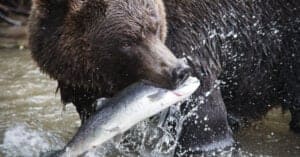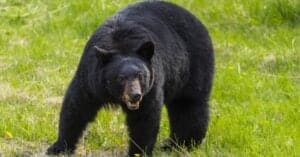Black Bear Population by State
How many black bears live in the United States? Here’s the ultimate guide to bear counts in 2021.
Meet the Black Bear
The North American black bear (Ursus americanus) is native to North America. It is the smallest of the three North American bear species, which include grizzlies and polar bears. It is typically solid black with a brown snout, but some black bears can be brown or even white. Some black bears have a white “crescent moon” patch on their chests, which is similar to the white patch worn by Asiatic black bears.
Where do black bears live?
They are in many U.S. states and every part of Canada except Prince Edward Island.
They mostly inhabit forested areas and mountain regions. Some black bears wander out of their forests into human communities. They’ve learned that these places are often sources of free food.
What do black bears eat?
They are omnivores who eat whatever is available. Black bears eat a mostly vegetarian diet of nuts, berries, acorns, and roots. They also eat insects, small animals, and meat left by other predators. Some black bears prey on fawns and moose calves, and those that live near rivers fish for spawning salmon.
What is their population in the United States?
The overall population of American black bears in the United States ranges from 250,000 to more than 300,000. This number, however, excludes populations from Texas, Mississippi, and Wyoming, whose population sizes are unknown.
It’s important to note that most bear population numbers are not exact. Estimating the size of wildlife populations is always difficult. It’s even more difficult when biologists try to track animals with large home ranges, like bears. This means most official numbers may be off by a few hundred to more than 1,000, but they are the best that government surveyors and wildlife biologists can figure out.
For our bear population numbers, we relied on official numbers from each state’s Fish and Wildlife Department, Department of Natural Resources, or another appropriate source.
Alabama: 200
There are an estimated 200 black bears in Alabama. Most have been reintroduced to the northeastern part of the state. Conservationists believe their population spread from northwest Georgia. Most of the bears in Alabama are members of the subspecies Florida black bear (Ursus americanus floridianus), which is a bear species native to Florida.
Alaska: 100,000
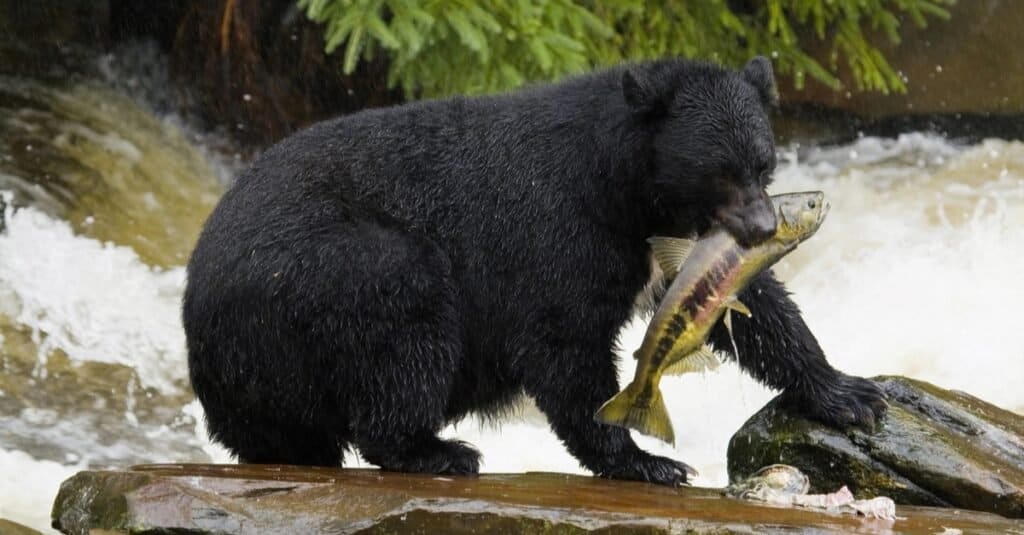
emperorcosar/Shutterstock.com
With 100,000 black bears, Alaska has one of the largest black bear populations in the country. According to the Alaska Department of Fish and Wildlife, black bears are the most abundant and widely distributed of the three North American bear species living in the state. They live in most of Alaska’s forested areas and most of the state’s islands. In the summer, they fish for spawning salmon in Alaska’s rivers.
Arizona: 3,000
The black bear is the only bear species in Arizona. The state has around 3,000 black bears living in coniferous forests, oak woodlands, chaparral, and mixed-wood forests.
Arkansas: 3,000
Black bears were once abundant in this state, and the state even went by the nickname “the Bear State.” Hunting and deforestation decimated their population. By the 1920s, only 25 bears remained in the entire state.
In 1958, the state began a major effort to reintroduce black bears. That effort is considered one of the greatest wildlife reintroduction successes in the world. Today, more than 3,000 bears live in the state, and their population is stable and growing.
California: 25,000 to 35,000
There are around 25,000 to 35,000 black bears in California. This makes it the largest population of black bears of any contiguous state. Since 1948, the state has classed black bears as game mammals, but the state has instituted restrictive laws on bear hunting licenses.
According to the California Department of Fish and Wildlife, the state’s black bear population is growing, and black bears are being seen in areas where there were no bears 50 years ago. These include the central coast and Transverse mountain ranges of southern California. The state’s bear population occupies 52,000 miles of land.
Colorado: 16,000
There are an estimated 16,000 black bears in Colorado. Most of the state’s bears live in the expansive oak and aspen forests. They primarily eat chokecherry and serviceberry. According to the Colorado Department of Parks and Wildlife, 90% of the state’s black bears are brown, honey-colored, or cinnamon-colored.
Connecticut: 800 to 1,000
Like Arkansas, Connecticut almost wiped out its black bear population by the start of the 20th century. Since the 1980s, black bears have made a comeback in the state. The state’s Department of Environmental Protection estimates there are 800 to 1,000 black bears in the state. Annual sightings of black bears have risen sharply every year, which leads biologists to believe that the black bear population is growing at a healthy pace.
Delaware: 0
There are no black bears in Delaware. The species is considered extirpated, which means it once lived here but no longer does.
Florida: 4,000
Florida has around 4,000 black bears. They are the only bear species in the state.
The state’s healthy black bear population is a triumph for local conservationists, who pushed to have the black bear listed on the state’s Endangered and Threatened Species List in the 1970s. At that time, the black bear population had fallen to around 300. The Fish and Wildlife Conservation Commission describes the population as widespread and robust.
Georgia: 5,000
Like other states, Georgia lost most of its bear population in the 1800s because of logging and deforestation. Today, there are over 5,000 bears in the state. Black bears primarily live in the northern mountains, along the Ocmulgee River, and in the Okefenokee Swamp.
Hawaii: 0
Hawaii has no black bears.
Idaho: 20,000 to 30,000

iStock.com/christiannafzger
Idaho has 20,000 to 30,000 black bears. The bear population is healthy and growing. Most of them live in the mountain ranges, the foothills near Boise, and the southwest part of the state. Idaho has many wild, untouched areas, and bears find plenty to eat there.
Illinois: 0
There are no black bears in Illinois. There are occasional black bear sightings in the state, but these bears are probably passing through from other states.
Indiana: 0
Black bears were once common in Indiana, but the species is considered extirpated now. There are no black bears in Indiana.
Iowa: 0
Iowa has no resident black bear population, but black bears pass through the state every spring. Most of them are migrating through Iowa from other states. These bear crossings are popular in Iowa. In 2020, a black bear named Bruno had more than 150,000 Facebook friends who followed his travels from Wisconsin to Missouri.
Kansas: 0
Kansas has no resident black bear population. The state occasionally gets visiting bears who are migrating from one neighboring state to another.
Kentucky: 1,000
The return of black bears to Kentucky is another wildlife success story. Once eliminated in the early 1900s, they have now returned. Kentucky officials did not plan to reintroduce black bears, but when massive logging and deforestation ended, the oak forests recovered. This drew bears from the neighboring states of West Virginia and Tennessee. Today, the state has 1,000 bears, and the population is growing.
Louisiana: 700 to 1,000
Louisiana has 700 to 1,000 black bears. The state’s black bears are members of an endemic subspecies, the Louisiana black bear (Ursus americanus luteolus). The Louisiana black bear is the state’s national mammal and a conservation success story.
Maine: 35,000
Maine has more black bears than any other New England state. The state’s Department of Inland Fisheries and Wildlife estimates there are more than 35,000 black bears in the state.
Maryland: 2,000
Maryland has more than 2,000 black bears. The state has breeding populations in the western counties of Garrett, Allegany, Frederick, and Washington. These counties are in mountainous, forested regions that are ideal for black bears.
Massachusetts: 4,500
Massachusetts has 4,500 black bears. This is surprising because Massachusetts is the third most densely populated state in the country after New Jersey and Rhode Island. The bear population thrives in the western and northern parts of the state.
Michigan: 15,000 to 19,000
Michigan officials estimate their black bear population is between 15,000 and 19,000. About 90% of those bears live in the Upper Peninsula region, which is characterized by dense conifer and hardwood forests. However, it is increasingly common to see bears in the Lower Peninsula.
Minnesota: 12,000 to 15,000
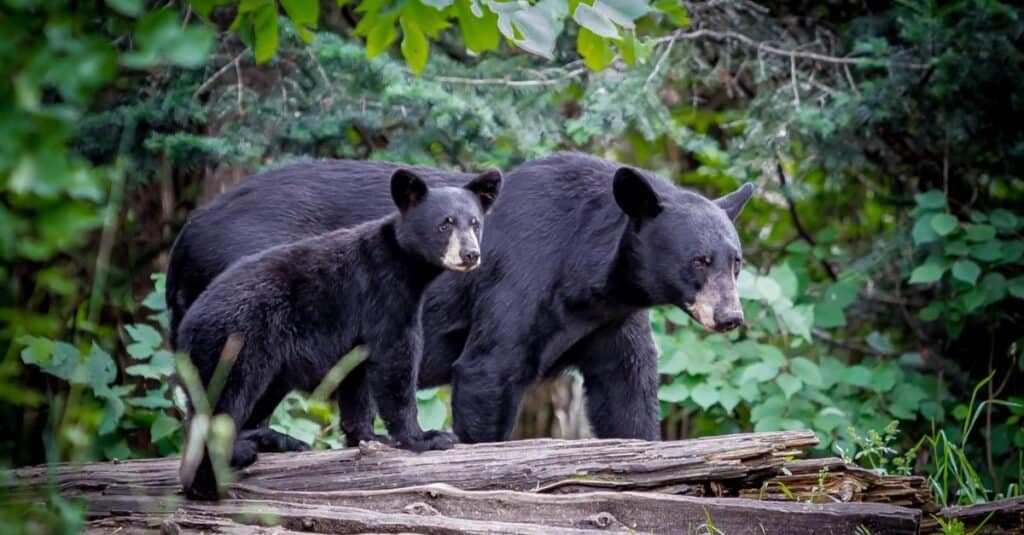
jo Crebbin/Shutterstock.com
12,000 to 15,000 black bears live in Minnesota. The black bear is the only bear population that lives in Minnesota. The bears live in the state’s forested areas and swamps. They mostly eat insects, berries, acorns, and hazelnuts.
Mississippi: Unknown
Mississippi once had thousands of black bears and Louisiana black bears. Today, both bear species have been extirpated because of habitat loss and hunting. State biologists estimate there are only about 40 bears at most in the state. Habitat restoration is taking place, however, and conservationists are hopeful that black bears and Louisiana black bears will both return.
Missouri: 1,000
The state has around 1,000 black bears. Most bears in the state live in the region south of the Missouri River. The bear population is thriving, and wildlife experts believe it will continue to grow.
Montana: 15,000
Montana has around 15,000 black bears. However, state wildlife officials believe the population might be even larger than previously estimated. The state also has the largest grizzly population in the country after Alaska. Montana allows controlled hunting of bears twice a year.
Nebraska: 0
There are no resident black bears in Nebraska.
Nevada: 500
There are 500 black bears living in Nevada’s “bear country,” which is primarily the western part of the state. These bears are part of the Sierra Nevada black bear population, which includes bears living in the Cascade Range of northern California and southern Oregon. The total estimated population of the Sierra Nevada group is 10,000 to 15,000 bears.
New Hampshire: 4,800 to 5,000
New Hampshire has 4,800 to 5,000 black bears. It is the only bear species in the state. That seems like a large number for a small state, but New Hampshire is rich in forested areas. The state uses controlled hunting to manage its bear population.
New Jersey: 3,000
Black bears have been seen in all 21 of New Jersey’s counties. The state has around 3,000 black bears. Because bears are thriving, there are increasing reports of black bears visiting suburban areas to look for food.
New Mexico: 5,000 to 6,000
There are 5,000 to 6,000 black bears in the state. The state has a long cultural history of protecting these bears. New Mexico has had laws protecting black bears since 1927. Like many states with healthy black bear populations, it issues a controlled number of hunting permits each year to manage the bear count.
New York: 6,000 to 8,000
New York has between 6,000 to 8,000 black bears. These bears primarily live in the western, northern, and southeastern parts of the state, which are more heavily forested. Many of them live in the Adirondack Park, a 6-million-acre forest preserve that is safe from development. These bears enjoy the Hudson River, Lake Champlain, and acres of untouched forest.
North Carolina: 20,000
There are more than 20,000 bears in the state. Of those, about 1,500 live in the Great Smoky Mountains National Park. The reintroduction of black bears is a conservation success story. North Carolina, like many states we’ve listed, once wiped out its bear population. Today, bear populations are healthy and thriving.
North Dakota: 0
North Dakota has no resident black bear population. Black bears have been spotted there, but they are probably crossing through on their way to another state.
Oklahoma: 2,500
Oklahoma has around 2,500 black bears. Most of these bears live in the Ouachita Mountains in the southeast or the Oklahoma Ozarks in the eastern central part of the state. The number of black bears in the state has steadily grown since 2011, and the current bears are thriving.
Ohio: 50 to 100
According to the state Department of Natural Resources, black bears have made a small comeback after being wiped out in Ohio. As Ohio’s woodlands have grown and more natural areas are being preserved, they have returned. Currently, there are an estimated 50 to 100 black bears in the state. That number continues to grow, however, and bear sightings are on the rise.
Oregon: 25,000 to 30,000
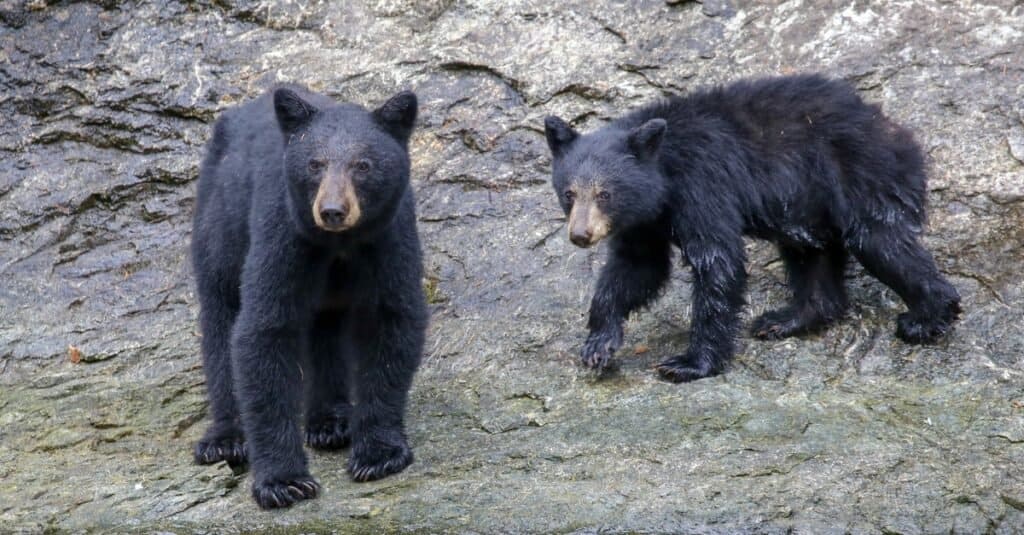
CSNafzger/Shutterstock.com
There are an estimated 25,000 to 30,000 black bears in Oregon. They are the only remaining bear species. They live in the state’s many large tracts of dense, unpopulated forests. Black bears in Oregon are mostly herbivores, but they will occasionally eat small mammals, fish, and the leftover carcasses of mountain lion kills.
Pennsylvania: 16,000
The black bear population of Pennsylvania is around 16,000. It is the only state on our list where the population has fallen. The state manages the bear population through controlled hunting, and state wildlife officials say the current number is a healthy one for the state.
Rhode Island: Unknown
Rhode Island wiped out its bear population, but it has recently reported a small comeback. Biologists believe a small group of bears from Connecticut has established a breeding site in Rhode Island. They think there may be 10 breeding bears, but these numbers are not confirmed.
South Carolina: 1,100
South Carolina has around 1,100 black bears. The state has two distinct black bear communities. Around 900 bears live in the mountains and Upper Piedmont area, and another 200 live in the coastal plain.
According to the state’s Department of Natural Resources, black bears are ranked as a “vulnerable” species in the state. While bears in the mountains still have plenty of space, the coastal bears are threatened by development and habitat fragmentation.
South Dakota: 0
There are no black bears in South Dakota. Bears occasionally roam through the Black Hills, but there is no resident bear population.
Tennessee: 5,500 to 6,000
Tennessee has 5,500 to 6,000 black bears. These bears primarily live in areas protected by the Great Smoky Mountains National Park and Cherokee National Forest. Like many states, Tennessee almost eliminated its black bear population at the start of the century, but conservation efforts have helped the bears thrive again.
Texas: Unknown
The black bear and Louisiana black bear were native to Texas, but both species were wiped out. Biologists believe there might be 30 to 40 resident breeding bears. Conservation efforts have focused on reintroducing black bears to Texas. They are considered a protected species in the state, and it is illegal to hunt or trap them.
Utah: 4,000
There are around 4,000 bears in Utah. Many of them live in the wild areas of Zion National Park, one of the largest national parks in the country. Bears do not commonly go into residential areas in Utah.
Vermont: 4,500 to 6,000
Vermont has many wild, forested areas, so it’s only natural it would have a healthy black bear population. It currently has from 4,500 to 6,000 bears in residence. The state has determined it can easily support this number of black bears, and it uses controlled hunting licenses to manage the population.
Virginia: 18,000 to 20,000
With an estimated population of 18,000 to 20,000, Virginia has a lot of black bears. They are the state’s largest land mammal, and their diet in Virginia is 75% vegetarian. With these high numbers, human encounters with bears have also increased, but there are no reported bear attacks.
Washington: 25,000 to 30,000
There are an estimated 25,000 to 30,000 black bears in Washington. They live in all parts of the state except the Columbia Plain, which does not have forests. Bears live in the coastal rainforests and the dry woodlands of the Cascade Mountains. The state is also home to grizzly bears.
West Virginia: 12,000 to 14,000
The black bear is West Virginia’s state mammal. Despite this, the state’s black bear population had diminished to under 500 by the 1970s. Since then, conservation efforts and better public understanding have allowed black bears to flourish once again. There are now an estimated 12,000 to 14,000 black bears, and they live in every county of West Virginia.
Wisconsin: 24,000
More than 24,000 black bears live in Wisconsin. Like other states with healthy black bear populations, Wisconsin has many forested wild areas. Black bears mostly live in the far northern region of the state, but they have increasingly been spotted in the southern regions.
Wyoming: Unknown
Wyoming only began counting black bears in 2019, although the state has always kept track of its grizzly population. Wildlife officials say the black bear population is robust and stable, but exact numbers are not available. About 500 black bears live in Yellowstone Park, which is primarily in Wyoming.
More from A-Z Animals
How many black bears live in the United States? Here’s the ultimate guide to bear counts in 2021.
Meet the Black Bear
The North American black bear (Ursus americanus) is native to North America. It is the smallest of the three North American bear species, which include grizzlies and polar bears. It is typically solid black with a brown snout, but some black bears can be brown or even white. Some black bears have a white “crescent moon” patch on their chests, which is similar to the white patch worn by Asiatic black bears.
Where do black bears live?
They are in many U.S. states and every part of Canada except Prince Edward Island.
They mostly inhabit forested areas and mountain regions. Some black bears wander out of their forests into human communities. They’ve learned that these places are often sources of free food.
What do black bears eat?
They are omnivores who eat whatever is available. Black bears eat a mostly vegetarian diet of nuts, berries, acorns, and roots. They also eat insects, small animals, and meat left by other predators. Some black bears prey on fawns and moose calves, and those that live near rivers fish for spawning salmon.
What is their population in the United States?
The overall population of American black bears in the United States ranges from 250,000 to more than 300,000. This number, however, excludes populations from Texas, Mississippi, and Wyoming, whose population sizes are unknown.
It’s important to note that most bear population numbers are not exact. Estimating the size of wildlife populations is always difficult. It’s even more difficult when biologists try to track animals with large home ranges, like bears. This means most official numbers may be off by a few hundred to more than 1,000, but they are the best that government surveyors and wildlife biologists can figure out.
For our bear population numbers, we relied on official numbers from each state’s Fish and Wildlife Department, Department of Natural Resources, or another appropriate source.
Alabama: 200
There are an estimated 200 black bears in Alabama. Most have been reintroduced to the northeastern part of the state. Conservationists believe their population spread from northwest Georgia. Most of the bears in Alabama are members of the subspecies Florida black bear (Ursus americanus floridianus), which is a bear species native to Florida.
Alaska: 100,000

emperorcosar/Shutterstock.com
With 100,000 black bears, Alaska has one of the largest black bear populations in the country. According to the Alaska Department of Fish and Wildlife, black bears are the most abundant and widely distributed of the three North American bear species living in the state. They live in most of Alaska’s forested areas and most of the state’s islands. In the summer, they fish for spawning salmon in Alaska’s rivers.
Arizona: 3,000
The black bear is the only bear species in Arizona. The state has around 3,000 black bears living in coniferous forests, oak woodlands, chaparral, and mixed-wood forests.
Arkansas: 3,000
Black bears were once abundant in this state, and the state even went by the nickname “the Bear State.” Hunting and deforestation decimated their population. By the 1920s, only 25 bears remained in the entire state.
In 1958, the state began a major effort to reintroduce black bears. That effort is considered one of the greatest wildlife reintroduction successes in the world. Today, more than 3,000 bears live in the state, and their population is stable and growing.
California: 25,000 to 35,000
There are around 25,000 to 35,000 black bears in California. This makes it the largest population of black bears of any contiguous state. Since 1948, the state has classed black bears as game mammals, but the state has instituted restrictive laws on bear hunting licenses.
According to the California Department of Fish and Wildlife, the state’s black bear population is growing, and black bears are being seen in areas where there were no bears 50 years ago. These include the central coast and Transverse mountain ranges of southern California. The state’s bear population occupies 52,000 miles of land.
Colorado: 16,000
There are an estimated 16,000 black bears in Colorado. Most of the state’s bears live in the expansive oak and aspen forests. They primarily eat chokecherry and serviceberry. According to the Colorado Department of Parks and Wildlife, 90% of the state’s black bears are brown, honey-colored, or cinnamon-colored.
Connecticut: 800 to 1,000
Like Arkansas, Connecticut almost wiped out its black bear population by the start of the 20th century. Since the 1980s, black bears have made a comeback in the state. The state’s Department of Environmental Protection estimates there are 800 to 1,000 black bears in the state. Annual sightings of black bears have risen sharply every year, which leads biologists to believe that the black bear population is growing at a healthy pace.
Delaware: 0
There are no black bears in Delaware. The species is considered extirpated, which means it once lived here but no longer does.
Florida: 4,000
Florida has around 4,000 black bears. They are the only bear species in the state.
The state’s healthy black bear population is a triumph for local conservationists, who pushed to have the black bear listed on the state’s Endangered and Threatened Species List in the 1970s. At that time, the black bear population had fallen to around 300. The Fish and Wildlife Conservation Commission describes the population as widespread and robust.
Georgia: 5,000
Like other states, Georgia lost most of its bear population in the 1800s because of logging and deforestation. Today, there are over 5,000 bears in the state. Black bears primarily live in the northern mountains, along the Ocmulgee River, and in the Okefenokee Swamp.
Hawaii: 0
Hawaii has no black bears.
Idaho: 20,000 to 30,000

iStock.com/christiannafzger
Idaho has 20,000 to 30,000 black bears. The bear population is healthy and growing. Most of them live in the mountain ranges, the foothills near Boise, and the southwest part of the state. Idaho has many wild, untouched areas, and bears find plenty to eat there.
Illinois: 0
There are no black bears in Illinois. There are occasional black bear sightings in the state, but these bears are probably passing through from other states.
Indiana: 0
Black bears were once common in Indiana, but the species is considered extirpated now. There are no black bears in Indiana.
Iowa: 0
Iowa has no resident black bear population, but black bears pass through the state every spring. Most of them are migrating through Iowa from other states. These bear crossings are popular in Iowa. In 2020, a black bear named Bruno had more than 150,000 Facebook friends who followed his travels from Wisconsin to Missouri.
Kansas: 0
Kansas has no resident black bear population. The state occasionally gets visiting bears who are migrating from one neighboring state to another.
Kentucky: 1,000
The return of black bears to Kentucky is another wildlife success story. Once eliminated in the early 1900s, they have now returned. Kentucky officials did not plan to reintroduce black bears, but when massive logging and deforestation ended, the oak forests recovered. This drew bears from the neighboring states of West Virginia and Tennessee. Today, the state has 1,000 bears, and the population is growing.
Louisiana: 700 to 1,000
Louisiana has 700 to 1,000 black bears. The state’s black bears are members of an endemic subspecies, the Louisiana black bear (Ursus americanus luteolus). The Louisiana black bear is the state’s national mammal and a conservation success story.
Maine: 35,000
Maine has more black bears than any other New England state. The state’s Department of Inland Fisheries and Wildlife estimates there are more than 35,000 black bears in the state.
Maryland: 2,000
Maryland has more than 2,000 black bears. The state has breeding populations in the western counties of Garrett, Allegany, Frederick, and Washington. These counties are in mountainous, forested regions that are ideal for black bears.
Massachusetts: 4,500
Massachusetts has 4,500 black bears. This is surprising because Massachusetts is the third most densely populated state in the country after New Jersey and Rhode Island. The bear population thrives in the western and northern parts of the state.
Michigan: 15,000 to 19,000
Michigan officials estimate their black bear population is between 15,000 and 19,000. About 90% of those bears live in the Upper Peninsula region, which is characterized by dense conifer and hardwood forests. However, it is increasingly common to see bears in the Lower Peninsula.
Minnesota: 12,000 to 15,000

jo Crebbin/Shutterstock.com
12,000 to 15,000 black bears live in Minnesota. The black bear is the only bear population that lives in Minnesota. The bears live in the state’s forested areas and swamps. They mostly eat insects, berries, acorns, and hazelnuts.
Mississippi: Unknown
Mississippi once had thousands of black bears and Louisiana black bears. Today, both bear species have been extirpated because of habitat loss and hunting. State biologists estimate there are only about 40 bears at most in the state. Habitat restoration is taking place, however, and conservationists are hopeful that black bears and Louisiana black bears will both return.
Missouri: 1,000
The state has around 1,000 black bears. Most bears in the state live in the region south of the Missouri River. The bear population is thriving, and wildlife experts believe it will continue to grow.
Montana: 15,000
Montana has around 15,000 black bears. However, state wildlife officials believe the population might be even larger than previously estimated. The state also has the largest grizzly population in the country after Alaska. Montana allows controlled hunting of bears twice a year.
Nebraska: 0
There are no resident black bears in Nebraska.
Nevada: 500
There are 500 black bears living in Nevada’s “bear country,” which is primarily the western part of the state. These bears are part of the Sierra Nevada black bear population, which includes bears living in the Cascade Range of northern California and southern Oregon. The total estimated population of the Sierra Nevada group is 10,000 to 15,000 bears.
New Hampshire: 4,800 to 5,000
New Hampshire has 4,800 to 5,000 black bears. It is the only bear species in the state. That seems like a large number for a small state, but New Hampshire is rich in forested areas. The state uses controlled hunting to manage its bear population.
New Jersey: 3,000
Black bears have been seen in all 21 of New Jersey’s counties. The state has around 3,000 black bears. Because bears are thriving, there are increasing reports of black bears visiting suburban areas to look for food.
New Mexico: 5,000 to 6,000
There are 5,000 to 6,000 black bears in the state. The state has a long cultural history of protecting these bears. New Mexico has had laws protecting black bears since 1927. Like many states with healthy black bear populations, it issues a controlled number of hunting permits each year to manage the bear count.
New York: 6,000 to 8,000
New York has between 6,000 to 8,000 black bears. These bears primarily live in the western, northern, and southeastern parts of the state, which are more heavily forested. Many of them live in the Adirondack Park, a 6-million-acre forest preserve that is safe from development. These bears enjoy the Hudson River, Lake Champlain, and acres of untouched forest.
North Carolina: 20,000
There are more than 20,000 bears in the state. Of those, about 1,500 live in the Great Smoky Mountains National Park. The reintroduction of black bears is a conservation success story. North Carolina, like many states we’ve listed, once wiped out its bear population. Today, bear populations are healthy and thriving.
North Dakota: 0
North Dakota has no resident black bear population. Black bears have been spotted there, but they are probably crossing through on their way to another state.
Oklahoma: 2,500
Oklahoma has around 2,500 black bears. Most of these bears live in the Ouachita Mountains in the southeast or the Oklahoma Ozarks in the eastern central part of the state. The number of black bears in the state has steadily grown since 2011, and the current bears are thriving.
Ohio: 50 to 100
According to the state Department of Natural Resources, black bears have made a small comeback after being wiped out in Ohio. As Ohio’s woodlands have grown and more natural areas are being preserved, they have returned. Currently, there are an estimated 50 to 100 black bears in the state. That number continues to grow, however, and bear sightings are on the rise.
Oregon: 25,000 to 30,000

CSNafzger/Shutterstock.com
There are an estimated 25,000 to 30,000 black bears in Oregon. They are the only remaining bear species. They live in the state’s many large tracts of dense, unpopulated forests. Black bears in Oregon are mostly herbivores, but they will occasionally eat small mammals, fish, and the leftover carcasses of mountain lion kills.
Pennsylvania: 16,000
The black bear population of Pennsylvania is around 16,000. It is the only state on our list where the population has fallen. The state manages the bear population through controlled hunting, and state wildlife officials say the current number is a healthy one for the state.
Rhode Island: Unknown
Rhode Island wiped out its bear population, but it has recently reported a small comeback. Biologists believe a small group of bears from Connecticut has established a breeding site in Rhode Island. They think there may be 10 breeding bears, but these numbers are not confirmed.
South Carolina: 1,100
South Carolina has around 1,100 black bears. The state has two distinct black bear communities. Around 900 bears live in the mountains and Upper Piedmont area, and another 200 live in the coastal plain.
According to the state’s Department of Natural Resources, black bears are ranked as a “vulnerable” species in the state. While bears in the mountains still have plenty of space, the coastal bears are threatened by development and habitat fragmentation.
South Dakota: 0
There are no black bears in South Dakota. Bears occasionally roam through the Black Hills, but there is no resident bear population.
Tennessee: 5,500 to 6,000
Tennessee has 5,500 to 6,000 black bears. These bears primarily live in areas protected by the Great Smoky Mountains National Park and Cherokee National Forest. Like many states, Tennessee almost eliminated its black bear population at the start of the century, but conservation efforts have helped the bears thrive again.
Texas: Unknown
The black bear and Louisiana black bear were native to Texas, but both species were wiped out. Biologists believe there might be 30 to 40 resident breeding bears. Conservation efforts have focused on reintroducing black bears to Texas. They are considered a protected species in the state, and it is illegal to hunt or trap them.
Utah: 4,000
There are around 4,000 bears in Utah. Many of them live in the wild areas of Zion National Park, one of the largest national parks in the country. Bears do not commonly go into residential areas in Utah.
Vermont: 4,500 to 6,000
Vermont has many wild, forested areas, so it’s only natural it would have a healthy black bear population. It currently has from 4,500 to 6,000 bears in residence. The state has determined it can easily support this number of black bears, and it uses controlled hunting licenses to manage the population.
Virginia: 18,000 to 20,000
With an estimated population of 18,000 to 20,000, Virginia has a lot of black bears. They are the state’s largest land mammal, and their diet in Virginia is 75% vegetarian. With these high numbers, human encounters with bears have also increased, but there are no reported bear attacks.
Washington: 25,000 to 30,000
There are an estimated 25,000 to 30,000 black bears in Washington. They live in all parts of the state except the Columbia Plain, which does not have forests. Bears live in the coastal rainforests and the dry woodlands of the Cascade Mountains. The state is also home to grizzly bears.
West Virginia: 12,000 to 14,000
The black bear is West Virginia’s state mammal. Despite this, the state’s black bear population had diminished to under 500 by the 1970s. Since then, conservation efforts and better public understanding have allowed black bears to flourish once again. There are now an estimated 12,000 to 14,000 black bears, and they live in every county of West Virginia.
Wisconsin: 24,000
More than 24,000 black bears live in Wisconsin. Like other states with healthy black bear populations, Wisconsin has many forested wild areas. Black bears mostly live in the far northern region of the state, but they have increasingly been spotted in the southern regions.
Wyoming: Unknown
Wyoming only began counting black bears in 2019, although the state has always kept track of its grizzly population. Wildlife officials say the black bear population is robust and stable, but exact numbers are not available. About 500 black bears live in Yellowstone Park, which is primarily in Wyoming.


